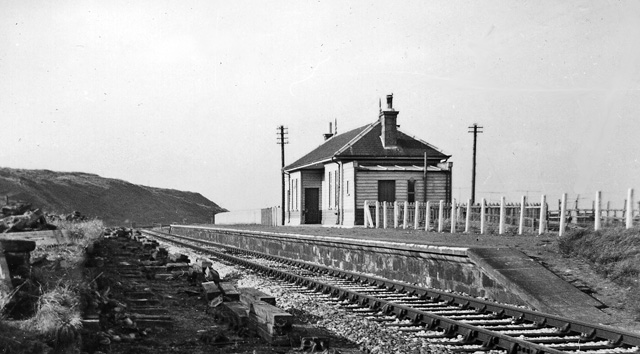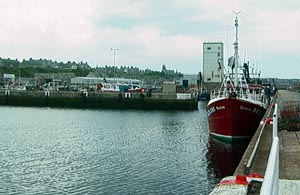|
Buckpool
Buckpool is a village on the coast of Moray, Scotland. Originally known as Nether Buckie, it is now effectively a part of the town of Buckie as the nearby fishing settlements merged as they expanded. Buckpool Harbour was built in 1857 by local laird, Sir Robert Gordon of Cluny. It was unpopular due to silting, hence fishermen moved to the larger Cluny Harbour in Buckie once it was completed by 1877. Buckpool Harbour was filled in with stones from the neighbouring Yardie beach in the 1970s and landscaped into a park. The Harbour now is the start/end of the Speyside Way walking route. Buckpool Golf Club Buckpool Golf Club's 18 hole links-style course was created in the 1930s. Part of the purpose of the project was to create jobs in a time of high unemployment, especially in the herring fishing industry. See also *Buckpool railway station Buckpool railway station was a railway station in Buckpool near Buckie in Moray. The railway station was opened by the Great North of Sco ... [...More Info...] [...Related Items...] OR: [Wikipedia] [Google] [Baidu] |
Buckpool Railway Station
Buckpool railway station was a railway station in Buckpool near Buckie in Moray. The railway station was opened by the Great North of Scotland Railway (GNoSR) on its Moray Firth coast line in 1886, served by Aberdeen to Elgin trains. The village and station were originally named Nether Buckie station and the station was renamed 'Buckpool' on 1 January 1887, closing to regular passenger traffic on 7 March 1960, several years before the closure of the line itself in 1968. In 1923 the GNoSR became part of the London and North Eastern Railway and at nationalisation in 1948 became part of British Railways. The line was recommended for closure by Dr Beeching's report "The Reshaping of British Railways" and closed on 6 May 1968. History Background In 1881 the Great North of Scotland Railway put a bill to parliament to extend its Portsoy line along the Moray Firth as far as Buckie. In 1882 the Great North of Scotland applied for permission to build a line from Portsoy following th ... [...More Info...] [...Related Items...] OR: [Wikipedia] [Google] [Baidu] |
Buckie
Buckie ( gd, Bucaidh) is a burgh town (defined as such in 1888) on the Moray Firth coast of Scotland. Historically in Banffshire, Buckie was the largest town in the county until the administrative area was abolished in 1975. The town is the third largest in the Moray council area after Elgin and Forres and within the definitions of statistics published by the General Register Office for Scotland was ranked at number 75 in the list of population estimates for settlements in Scotland mid-year 2006. Buckie is virtually equidistant to Banff to the east and Elgin to the west, with both approximately distant whilst Keith lies to the south by road. Etymology The origin of the name of the town is not entirely clear. Although the folk etymology is that Buckie is named after a seashell (genus ''buccinum'') the reality is that the shared marine background is a coincidence. The name Buckie would not have originally identified a place immediately adjacent to the sea, so alternative ... [...More Info...] [...Related Items...] OR: [Wikipedia] [Google] [Baidu] |
Buckpool Golf Club
Buckpool Golf Club is located in Buckie, Moray on the Moray Firth coast of Scotland. This 18 hole course is set out on a clifftop location at the extreme western end of Buckpool. UK Golf Guide describes it as a ''links course with superlative view over Moray Firth'' The course was created in the 1930s and part of the purpose of the project was to create jobs in a time of high unemployment, especially in the herring fishing industry. Golf website St Andrews.codescribes Buckpool thus whilst reflecting on its origins as a job creation scheme, ''for a course of this quality some of today's multi-millionaire course designers would be shaking in their soft-spikes if such schemes were resurrected.'' In the early sixties the Town Council, which had maintained both Buckpool and Buckie's other course Strathlene decided to close Buckpool due to economic reasons. A group of enthusiasts formed a private club and leased the course which has come a long way from the old farmhouse which was the cl ... [...More Info...] [...Related Items...] OR: [Wikipedia] [Google] [Baidu] |
Buckpool Rauilway Station 1934513 20d1f683
Buckpool is a village on the coast of Moray, Scotland. Originally known as Nether Buckie, it is now effectively a part of the town of Buckie as the nearby fishing settlements merged as they expanded. Buckpool Harbour was built in 1857 by local laird, Sir Robert Gordon of Cluny. It was unpopular due to silting, hence fishermen moved to the larger Cluny Harbour in Buckie once it was completed by 1877. Buckpool Harbour was filled in with stones from the neighbouring Yardie beach in the 1970s and landscaped into a park. The Harbour now is the start/end of the Speyside Way walking route. Buckpool Golf Club Buckpool Golf Club's 18 hole links-style course was created in the 1930s. Part of the purpose of the project was to create jobs in a time of high unemployment, especially in the herring fishing industry. See also *Buckpool railway station Buckpool railway station was a railway station in Buckpool near Buckie in Moray. The railway station was opened by the Great North of Scot ... [...More Info...] [...Related Items...] OR: [Wikipedia] [Google] [Baidu] |
Moray
Moray () gd, Moireibh or ') is one of the 32 local government council areas of Scotland. It lies in the north-east of the country, with a coastline on the Moray Firth, and borders the council areas of Aberdeenshire and Highland. Between 1975 and 1996 Moray, with similar boundaries, was a district of the then Grampian Region. History The name, first attested around 970 as ', and in Latinised form by 1124 as ', derives from the earlier Celtic forms *''mori'' 'sea' and *''treb'' 'settlement' (c.f. Welsh ''môr-tref''). During the Middle Ages, the Province of Moray was much larger than the modern council area, also covering much of what is now Highland and Aberdeenshire. During this period Moray may for a time have been either an independent kingdom or a highly autonomous vassal of Alba. In the early 12th century, Moray was defeated by David I of Scotland following a conflict with Óengus of Moray, and rule over the area was passed to William fitz Duncan. After that the title be ... [...More Info...] [...Related Items...] OR: [Wikipedia] [Google] [Baidu] |
Speyside Way
The Speyside Way (Doric: '; gd, Slighe Shrath Spe) is a long-distance path in the Scottish Highlands. The route begins in Buckie and ends at Newtonmore, away. There is an optional spur leading off the main route to Tomintoul, adding and of ascent. The route primarily follows the River Spey through the scenery of Banffshire, Morayshire and Inverness-shire in Scotland, passing some of the distilleries that produce Speyside single malts. The first section from Buckie to Spey Bay follows the coastline, while the final section from Aviemore to Newtonmore follows most of the route of the former Strathspey Railway. It is listed as one of Scotland's Great Trails by NatureScot, and links directly to two further Great Trails: the Dava Way and the Moray Coast Trail. About 52,750 people use the path every year, of whom about 2,750 complete the entire route. As with the other Great Trails, the Way is waymarked with a symbol showing a thistle in a hexagon. The Way was opened in 1981, fr ... [...More Info...] [...Related Items...] OR: [Wikipedia] [Google] [Baidu] |
Links (golf)
A links is the oldest style of golf course, first developed in Scotland. Links courses are generally built on sandy coastland that offers a firmer playing surface than parkland and heathland courses. The word "links" comes via the Scots language from the Old English word '' hlinc'': "rising ground, ridge" and refers to an area of coastal sand dunes and sometimes to open parkland; it is cognate with ''lynchet''. "Links" can be treated as singular even though it has an "s" at the end and occurs in place names that precede the development of golf, for example Lundin Links in Fife. It also retains this more general meaning in standard Scottish English. Links land is typically characterised by dunes, an undulating surface, and a sandy soil unsuitable for arable farming but which readily supports various indigenous browntop bent and red fescue grasses. Together, the soil and grasses result in the firm turf associated with links courses and the 'running' game. The hard surface typic ... [...More Info...] [...Related Items...] OR: [Wikipedia] [Google] [Baidu] |
Villages In Moray
A village is a clustered human settlement or community, larger than a hamlet but smaller than a town (although the word is often used to describe both hamlets and smaller towns), with a population typically ranging from a few hundred to a few thousand. Though villages are often located in rural areas, the term urban village is also applied to certain urban neighborhoods. Villages are normally permanent, with fixed dwellings; however, transient villages can occur. Further, the dwellings of a village are fairly close to one another, not scattered broadly over the landscape, as a dispersed settlement. In the past, villages were a usual form of community for societies that practice subsistence agriculture, and also for some non-agricultural societies. In Great Britain, a hamlet earned the right to be called a village when it built a church. [...More Info...] [...Related Items...] OR: [Wikipedia] [Google] [Baidu] |



